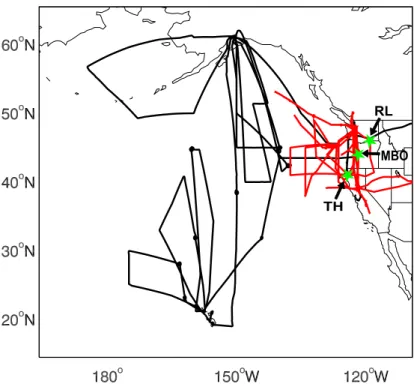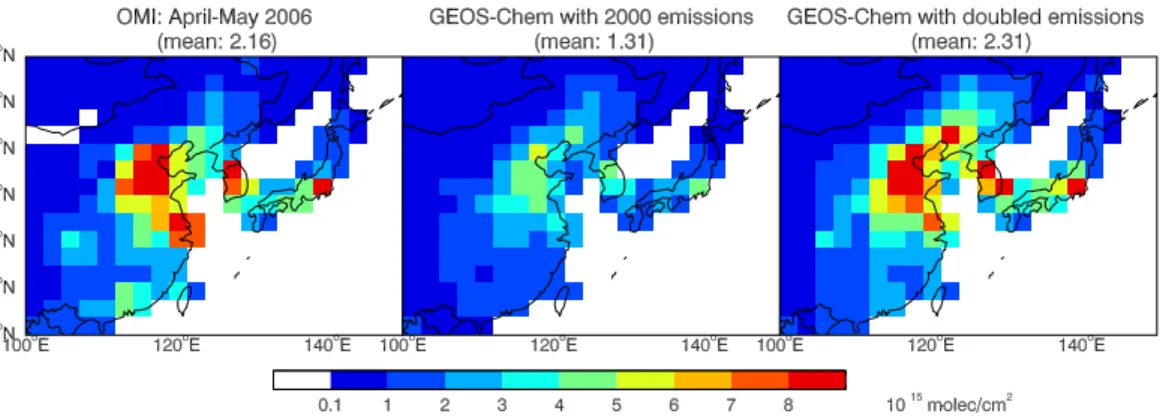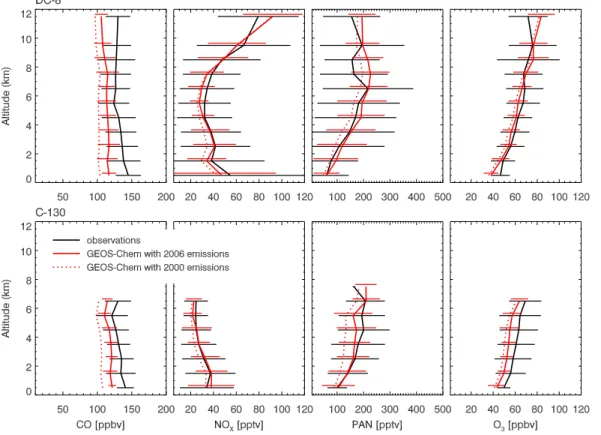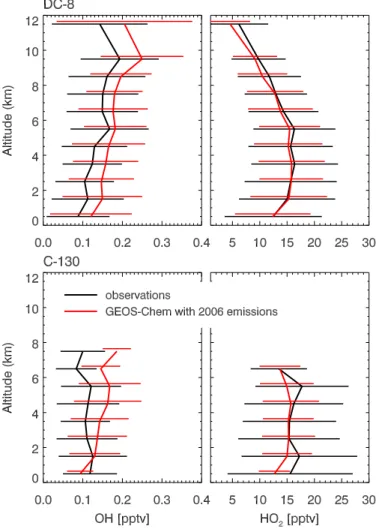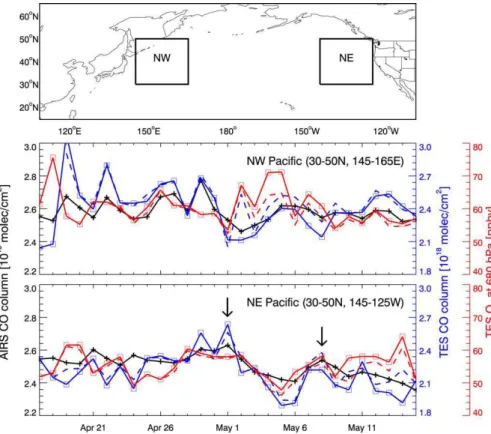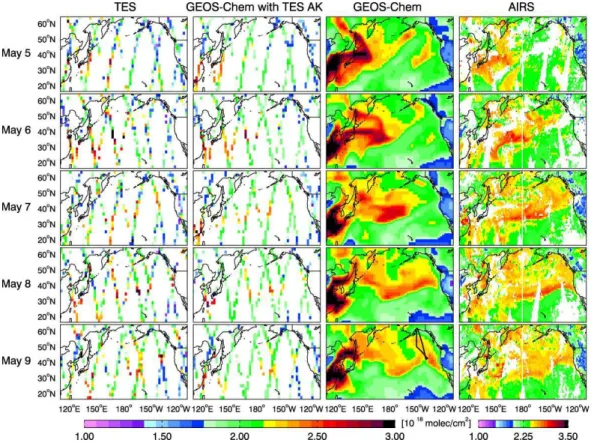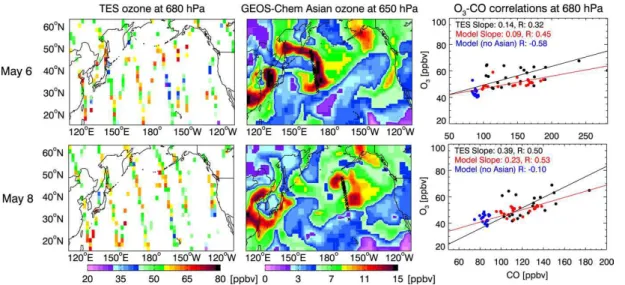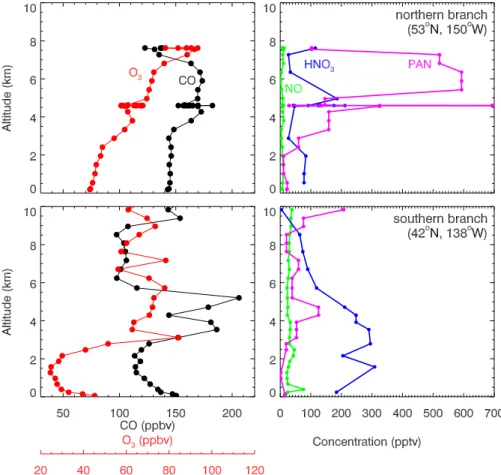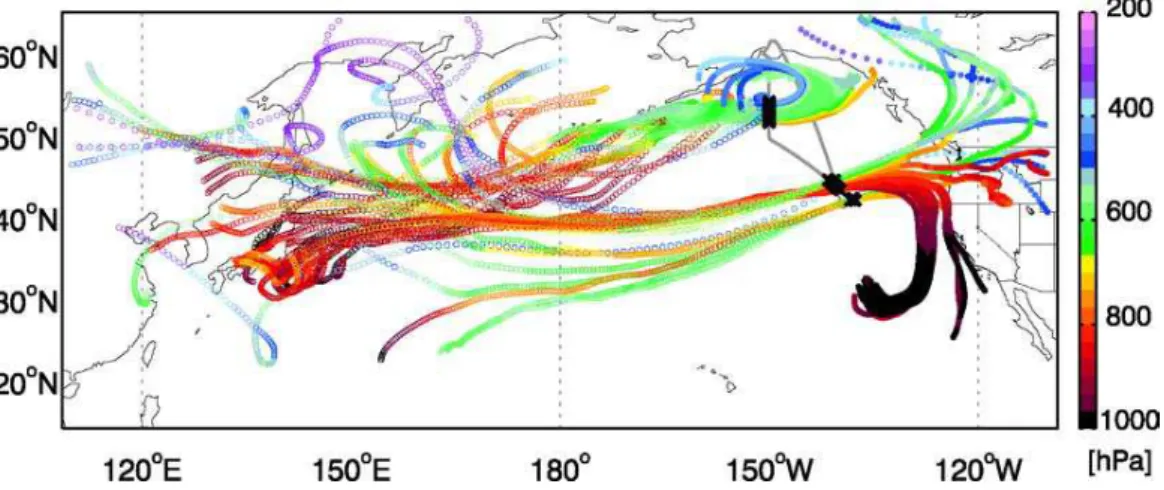ACPD
8, 8143–8191, 2008
Transpacific transport of ozone
pollution L. Zhang
Title Page Abstract Introduction Conclusions References
Tables Figures
◭ ◮
◭ ◮
Back Close
Full Screen / Esc
Printer-friendly Version Interactive Discussion
Atmos. Chem. Phys. Discuss., 8, 8143–8191, 2008 www.atmos-chem-phys-discuss.net/8/8143/2008/
© Author(s) 2008. This work is distributed under the Creative Commons Attribution 3.0 License.
Atmospheric Chemistry and Physics Discussions
Transpacific transport of ozone pollution and the e ff ect of recent Asian emission increases on air quality in North America:
an integrated analysis using satellite, aircraft, ozonesonde, and surface
observations
L. Zhang1,D. J. Jacob1,2,K. F. Boersma2,∗,D. A. Jaffe3,J. R. Olson4,K. W. Bow- man5,J. R. Worden5,A. M. Thompson6,M. A. Avery4,R. C. Cohen7,J. E. Dibb8, F. M. Flocke9,H. E. Fuelberg10,L. G. Huey11,W. W. McMillan12,H. B. Singh13,and A. J. Weinheimer14
1Dept. of Earth and Planetary Sciences, Harvard University, Cambridge, MA 02138, USA
2School of Engineering and Applied Sciences, Harvard Univ., Cambridge, MA 02138, USA
3University of Washington, 18115 Campus Way NE, Bothell, WA 98021, USA
4Atmospheric Sciences Division, Langley Research Center, NASA, Hampton, VA 23681, USA
5Jet Propulsion Laboratory, California Institute of Technology, 4800 Oak Grove Drive, Pasadena, CA 91109, USA
ACPD
8, 8143–8191, 2008
Transpacific transport of ozone
pollution L. Zhang
Title Page Abstract Introduction Conclusions References
Tables Figures
◭ ◮
◭ ◮
Back Close
Full Screen / Esc
Printer-friendly Version Interactive Discussion 6The Pennsylvania State University, Department of Meteorology, 503 Walker Building, Univer-
sity Park, PA 16802-5013 USA
7Department of Chemistry, University of California, Berkeley, CA 94720, USA
8University of New Hampshire, Climate Change Research Center, 39 College Road, Durham, NH 03824, USA
9Earth Observing Lab., National Center for Atmospheric Research, Boulder, CO 80307, USA
10Department of Meteorology, Florida State University, Tallahassee, FL 32306-4520, USA
11School of Earth and Atmospheric Sciences, Georgia Institute of Technology, Atlanta, GA 30332-0340, USA
12Department of Physics, University of Maryland Baltimore County, 1000 Hilltop Circle, Baltimore, MD 21250, USA
13NASA Ames Research Center, MS-245-5, Moffett Field, CA 94035, USA
14National Center for Atmospheric Res., 1850 Table Mesa Drive, Boulder, CO 80305, USA
∗now at: KNMI, PO Box 201, 3730 AE De Bilt, The Netherlands
Received: 26 March 2008 – Accepted: 31 March 2008 – Published: 24 April 2008 Correspondence to: L. Zhang (linzhang@fas.harvard.edu)
Published by Copernicus Publications on behalf of the European Geosciences Union.
ACPD
8, 8143–8191, 2008
Transpacific transport of ozone
pollution L. Zhang
Title Page Abstract Introduction Conclusions References
Tables Figures
◭ ◮
◭ ◮
Back Close
Full Screen / Esc
Printer-friendly Version Interactive Discussion
Abstract
We use an ensemble of aircraft, satellite, sonde, and surface observations for April–
May 2006 (NASA/INTEX-B aircraft campaign) to better understand the mechanisms for transpacific ozone pollution and its implications for North American air quality. The ob- servations are interpreted with a global 3-D chemical transport model (GEOS-Chem).
5
OMI NO2satellite observations constrain Asian anthropogenic NOxemissions and in- dicate a factor of 2 increase from 2000 to 2006 in China. Satellite observations of CO from AIRS and TES indicate two major events of Asian transpacific pollution dur- ing INTEX-B. Correlation between TES CO and ozone observations shows evidence for transpacific ozone pollution. The semi-permanent Pacific High and Aleutian Low
10
cause splitting of transpacific pollution plumes over the Northeast Pacific. The north- ern branch circulates around the Aleutian Low and has little impact on North America.
The southern branch circulates around the Pacific High and impacts western North America. Both aircraft measurements and model results show sustained ozone produc- tion driven by peroxyacetylnitrate (PAN) decomposition in the southern branch, roughly
15
doubling the transpacific influence from ozone produced in the Asian boundary layer.
Model simulation of ozone observations at Mt. Bachelor Observatory in Oregon (2.7 km altitude) indicates a mean Asian ozone pollution contribution of 9±3 ppbv to the mean observed concentration of 54 ppbv, reflecting mostly an enhancement in background ozone rather than episodic Asian plumes. Asian pollution enhanced surface ozone
20
concentrations by 5–7 ppbv over western North America in spring 2006. The 2000–
2006 rise in Asian anthropogenic emissions increased the influence by 1–2 ppbv.
1 Introduction
Rapid industrial development in eastern Asia and specifically in China has resulted in unprecedented growth in NOxemissions with implications for both regional and global
25
tropospheric ozone (Wild and Akimoto, 2001). Efforts to improve US air quality through
ACPD
8, 8143–8191, 2008
Transpacific transport of ozone
pollution L. Zhang
Title Page Abstract Introduction Conclusions References
Tables Figures
◭ ◮
◭ ◮
Back Close
Full Screen / Esc
Printer-friendly Version Interactive Discussion
domestic emission controls could be partly offset by Asian industrialization and the associated transpacific transport of pollution (Jacob et al., 1999; Fiore et al., 2002).
Better understanding the impact of rising Asian NOx emissions on transpacific ozone pollution and surface ozone air quality in the United States is therefore of great inter- est. We address this issue here through a global 3-D model analysis of observations
5
from the NASA Intercontinental Chemical Transport Experiment – Phase B (INTEX-B) aircraft campaign, conducted in spring 2006 over the Northeast Pacific. We integrate into our analysis concurrent measurements from ground sites, sondes, and satellites.
Ozone is produced in the troposphere by the photochemical oxidation of CO and volatile organic compounds (VOCs) in the presence of nitrogen oxides
10
(NOx≡NO+NO2). On a global scale, the photochemical production of ozone dominates the stratospheric influx (Prather and Ehhalt, 2001; Sudo and Akimoto, 2007), and is lim- ited mostly by the supply of NOx and methane (Wang et al., 1998b). Anthropogenic sources of NOx from combustion combined with the global rise in methane have prob- ably doubled the tropospheric ozone burden in the northern hemisphere over the past
15
century (Prather and Ehhalt, 2001). Ozone has a lifetime of days in the continental boundary layer but weeks in the free troposphere (Jacob et al., 1996; Thompson et al., 1996; Wang et al., 1998b; Fiore et al., 2002), and thus can affect continents downwind.
The dependence of ozone production on NOxis highly nonlinear; the ozone produc- tion efficiency (OPE) per unit NOxconsumed increases rapidly as the NOxconcentra-
20
tion decreases (Liu et al., 1987). Ozone production within the continental boundary layer is relatively inefficient because of the high-NOx conditions. A small fraction of emitted NOx exported to the free troposphere by frontal lifting, deep convection, or boundary layer venting can lead to disproportionately large ozone production in the free troposphere over the continent and downwind (Jacob et al., 1993; Thompson et
25
al., 1994). The peroxyacetylnitrate (PAN) reservoir for NOx can be vented from the boundary layer and transported on a global scale at cold temperatures, eventually decomposing to release NOx in the remote troposphere as air masses subside and producing ozone with very high efficiency. Previous studies using aircraft measure-
ACPD
8, 8143–8191, 2008
Transpacific transport of ozone
pollution L. Zhang
Title Page Abstract Introduction Conclusions References
Tables Figures
◭ ◮
◭ ◮
Back Close
Full Screen / Esc
Printer-friendly Version Interactive Discussion
ments from the PHOBEA, TRACE-P, and ITCT-2K2 campaigns (Kotchenruther et al., 2001; Heald et al., 2003; Hudman et al., 2004) found that PAN decomposition may represent a dominant component of the ozone enhancement in transpacific Asian pol- lution plumes. The INTEX-B campaign offers far more geographical coverage over the Northeast Pacific and enables a better understanding of the mechanisms of ozone
5
production in transpacific plumes.
Asian pollution is typically exported to the Pacific via frontal lifting in warm conveyor belts (WCBs), convection, and orographic lifting (Liu et al., 2003; Liang et al., 2004;
Kiley et al., 2006; Dickerson et al., 2007). It can then be transported across the Pacific in 5–10 days in plumes (Yienger et al., 2000; Jaffe et al., 2001; Stohl et al., 2002),
10
though mean transport times are of the order of 2–3 weeks (Liu and Mauzerall, 2005).
The transport is most rapid and frequent in spring due to active cyclonic activity and strong westerly winds (Forster et al., 2004; Liang et al., 2004). While Asian plumes with correlated CO and ozone are often observed in the free troposphere and at mountain sites over the western United States (Price et al., 2004; Jaffe et al., 2005; Weiss-
15
Penzias et al., 2007), no such plumes are observed at the surface for ozone (Goldstein et al., 2004), presumably because of dilution during entrainment into the boundary layer (Hudman et al., 2004). Asian ozone pollution in U.S. surface air thus mostly reflects an increase in background concentrations (Fiore et al., 2003). Background ozone levels in air entering western North America have increased approximately 10 ppbv between
20
1984 and 2002 (Jaffe et al., 2003) and ozone concentrations across the western United States show a significant increase with a mean trend of 0.26 ppbv y−1(Jaffe and Ray, 2007). The causes for these increases are not clear but rising Asian emissions may be a contributing source.
A unique feature of the INTEX-B campaign was the availability of extensive satellite
25
observations of tropospheric ozone, NO2, and CO to complement the aircraft obser- vations. Satellites have been providing a growing resource to quantify emissions of ozone precursors (Martin et al., 2006) and to map the transpacific transport of pollu- tants (Heald et al., 2003, 2006). They greatly expand the temporal and spatial scale of
ACPD
8, 8143–8191, 2008
Transpacific transport of ozone
pollution L. Zhang
Title Page Abstract Introduction Conclusions References
Tables Figures
◭ ◮
◭ ◮
Back Close
Full Screen / Esc
Printer-friendly Version Interactive Discussion
in situ measurements but are limited in precision, vertical resolution, and the number of species observed. Aircraft vertical profiles during INTEX-B provided validation data for the OMI (NO2), AIRS (CO), and TES (ozone, CO) satellite sensors (Boersma et al., 2008; Luo et al., 2007b; Richards et al., 2008). Here we use these satellite observa- tions to constrain Asian NOxemissions (NO2from OMI), track transpacific plumes (CO
5
from AIRS as a long-lived pollution tracer), and observe ozone production in transpa- cific Asian plumes (ozone and CO from TES). We examine the consistency between the satellite and aircraft information and apply the aircraft data to further analysis of plume chemistry. We also use sonde data from INTEX Ozonesonde Network Study (IONS) (Thompson et al., 2008) to test model results, and use ground-based measure-
10
ments at Mount Bachelor Observatory in central Oregon (Jaffe et al., 2005; Reidmiller et al., 20081) to link Asian pollution influences observed by satellite and aircraft in the free troposphere to North American surface air quality.
2 Observations and model 2.1 In-situ measurements
15
The NASA INTEX-B aircraft mission took place from 17 April to 15 May 2006 over the Northeast Pacific and the west coast of North America (Singh et al., 20082). It used the NASA DC-8 (ceiling 12 km) as its primary platform operating out of Honolulu and Anchorage, complemented with the NSF/NCAR C-130 (ceiling 7 km) operating out of Seattle. Figure 1 shows the flights tracks of the DC-8 and C-130 aircraft. These
20
1Reidmiller, D. R., Jaffe, D. A., Strode, S., et al.: Interannual variability of CO in the free troposphere at the Mt. Bachelor Observatory: INTEX-B results in the context of 2004–2007, Atmos. Chem. Phys. Discuss., manuscript in preparation, 2008.
2Singh, H. B., Brune, W. H., Crawford, J. H., Jacob, D. J., Russell, P. B., et al.: An Overview of the INTEX-B Campaign: Transport and Transformation of Pollutants over the Pacific and the Gulf of Mexico, Atmos. Chem. Phys. Discuss., manuscript in preparation, 2008.
ACPD
8, 8143–8191, 2008
Transpacific transport of ozone
pollution L. Zhang
Title Page Abstract Introduction Conclusions References
Tables Figures
◭ ◮
◭ ◮
Back Close
Full Screen / Esc
Printer-friendly Version Interactive Discussion
included extensive vertical profiling on all flights. The DC-8 conducted 10 science flights of about 9-h duration each, with large latitudinal coverage over the Northeast Pacific. The C-130 conducted 12 science flights of about 8-h duration each off and over the west coast. Quasi-Lagrangian sampling studies were performed between the DC-8 and the C-130 to track the chemical evolution of Asian pollution plumes (Latto
5
and Fuelberg, 2007).
Details of the chemical payload on both aircraft are given by Singh et al., 20082. We principally make use here of the 1-minute average measurements of ozone, CO, NO, NO2, PAN, OH, and HO2. Intercomparisons between the two aircraft show ex- cellent agreement for ozone, CO, and NOx, but for PAN the correlation is poor and
10
C-130 measurements are 23% higher than DC-8 on average as discussed in Chen et al. (2007).
Additional in situ data for the INTEX-B period analyzed in our study include ozonesonde observations at Trinidad Head (California) and Richland (Washington) made during the IONS-06 collaborative field campaign (Thompson et al., 2008;http:
15
//croc.gsfc.nasa.gov/intexb/ions06.html), and surface measurements at Mount Bache- lor Observatory (MBO, 44.0◦N, 121.7◦W, 2.7 km altitude in Oregon) (Wolfe et al., 2007;
Reidmiller et al.).
2.2 Satellites
We use satellite observations from OMI and TES aboard Aura and AIRS aboard Aqua.
20
Aura was launched in July 2004 into a polar, sun-synchronous orbit with ascending equator crossing around 1345 local time. The Ozone Monitoring Instrument (OMI) is a nadir-scanning instrument which measures backscattered solar radiation over the 270–500 nm wavelength range with a spectral resolution of 0.42–0.63 nm (Levelt et al., 2006). It has a spatial resolution of 13×24 km2 at nadir and daily global coverage.
25
We use here near-real time (NRT) tropospheric NO2columns retrieved by KNMI/NASA (Boersma et al., 2007). This product was successfully validated with DC-8 NO2vertical profiles (Boersma et al., 2008).
ACPD
8, 8143–8191, 2008
Transpacific transport of ozone
pollution L. Zhang
Title Page Abstract Introduction Conclusions References
Tables Figures
◭ ◮
◭ ◮
Back Close
Full Screen / Esc
Printer-friendly Version Interactive Discussion
The Tropospheric Emission Spectrometer (TES) is a Fourier transform IR emission spectrometer with high spectral resolution (0.1 cm−1 apodized) and a wide spectral range (650–3050 cm−1), enabling retrieval of both tropospheric ozone and CO in the nadir based on optimal estimation techniques (Beer et al., 2006; Bowman et al., 2006).
Joint retrieval of ozone and CO enables TES to diagnose ozone pollution influences
5
through O3-CO correlations (Zhang et al., 2006). During INTEX-B, TES alternated daily between “global survey” and “step-and-stare” observational modes. The stan- dard products (“global surveys”) consist of 16 daily orbits across the North Pacific with retrievals spaced 1.6◦ along the orbit track. The “step-and-stare” observations have denser nadir coverage along the orbit track over the North Pacific. Vertical profiles re-
10
trieved from TES provide 1–2 degrees of freedom for signal (DOFS) for ozone in the troposphere corresponding to about 6 km vertical resolution, and about 1 DOFS for CO weighted towards the middle troposphere (Worden et al., 2004). We use V002 of TES data. Validation with ozonesondes and INTEX-B aircraft data shows that TES ozone profiles are biased high by 3–10 ppbv (Nassar et al., 2008; Richards et al., 2008). TES
15
CO measurements are consistent with those from MOPITT (Luo et al., 2007a) and within±15% of the INTEX-B aircraft data (Luo et al., 2007b). We filter out retrievals with poor sensitivity (diagonal term of the averaging kernel matrix at 681 hPa<0.01). To ensure that our conclusions are not affected by the variable a priori used to regularize the TES retrievals, we reprocess the TES profiles using a fixed a priori following Zhang
20
et al. (2006).
The Atmospheric Infrared Sounder (AIRS) was launched on the NASA Aqua satellite in May 2002. It is a cross-track scanning grating spectrometer covering the 3.7 to 16µm spectral range with 2378 channels (Aumann et al., 2003). AIRS has a spatial resolution of 45 km at nadir and a 1650 km cross-track swath, enabling daily global coverage. CO
25
retrievals are obtained at 4.7µm including for partly cloudy scenes (McMillan et al., 2005). We use version 4.2 of AIRS CO retrievals (McMillan et al., 2008). AIRS shows a positive bias of 15–20 ppbv relative to MOPITT over the oceans (Warner et al., 2007).
Here we use AIRS observations of CO column qualitatively due to lack of well-defined
ACPD
8, 8143–8191, 2008
Transpacific transport of ozone
pollution L. Zhang
Title Page Abstract Introduction Conclusions References
Tables Figures
◭ ◮
◭ ◮
Back Close
Full Screen / Esc
Printer-friendly Version Interactive Discussion
averaging kernels in version 4.2.
2.3 Model description
We use the GEOS-Chem global 3-D model of tropospheric chemistry (v7-04-09;
http://www.as.harvard.edu/chemistry/trop/geos/) driven by GEOS-4 assimilated me- teorological observations from the NASA Global Modeling and Assimilation Office
5
(GMAO). The model is applied to a global simulation of ozone-NOx-VOC-aerosol chem- istry. General descriptions of GEOS-Chem are given by Bey et al. (2001) and Park et al. (2004), and previous applications to transpacific ozone chemistry include studies by Fiore et al. (2002), Jaegl ´e et al. (2003), Weiss-Penzias et al. (2004), Bertschi et al. (2004), Goldstein et al. (2004), Hudman et al. (2004), and Liang et al. (2007).
10
Meteorological fields in the GEOS-4 data have a temporal resolution of 6 h (3 h for surface variables and mixing depths) and a horizontal resolution of 1◦latitude by 1.25◦ longitude, with 55 levels in the vertical. We degrade the horizontal resolution to 2◦ latitude by 2.5◦longitude for input to GEOS-Chem. The simulations are conducted for April–May 2006 at 2◦×2.5◦ resolution. They are initialized on 1 April 2006 with GEOS-
15
Chem fields generated by an 8-month spin-up simulation with 4◦×5◦resolution.
Zhang et al.3(http://www.cgrer.uiowa.edu/EMISSION DATA new/index 16.html) compiled a detailed anthropogenic emission inventory for Asia (8◦N–50◦N, 80◦E–
150◦E) for the spring 2006 period of INTEX-B (hereafter referred to as S2006). We use their emission estimates except for NOx which we derive instead from OMI NO2
20
data as a better estimate (Sect. 3). For anthropogenic emissions in the United States we use the National Emission Inventory for 1999 (NEI 99) from the US Environmental Protection Agency (EPA) (http://www.epa.gov/ttn/chief/net/). For the rest of the world we use anthropogenic emissions from the Global Emission Inventory Activity (GEIA), scaled to 1998 on the basis of national energy statistics as described by Bey et
25
3Zhang, Q., Streets, D. G., He, K., et al., A new inventory of anthropogenic emissions in Asia for the year 2005/2006, Atmos. Chem. Phys. Discuss., manuscript in preparation, 2008.
ACPD
8, 8143–8191, 2008
Transpacific transport of ozone
pollution L. Zhang
Title Page Abstract Introduction Conclusions References
Tables Figures
◭ ◮
◭ ◮
Back Close
Full Screen / Esc
Printer-friendly Version Interactive Discussion
al. (2001).
Streets et al. (2003) previously reported an anthropogenic emission inventory for Asia in 2000 (hereafter referred to as S2000), and we will use that inventory in a sensi- tivity simulation to assess the impact of rising Asian emissions from 2000 to 2006. For the same Asian region, the S2006 inventory is 41% higher for CO, 45% higher for non-
5
methane volatile organic compound (NMVOCs), and 65% higher for NOx. Our NOx source constrained by the OMI NO2observations is 2 times higher than S2000. Some of the change in the CO inventory in S2006 relative to S2000 reflects an underestimate in the original inventory (Streets et al., 2006), in addition to emission growth. The in- crease in NMVOCs reflects emission growth and is consistent with Ohara et al. (2007).
10
The increase in NOxalso mainly reflects emission growth, as will be discussed in Sect.
3.
Biomass burning emissions are from a monthly climatological inventory (Duncan et al., 2003). Fire emissions over Southeast Asia in 2006 were not unusual compared with previous years (van der Werf et al., 2006;http://ess1.ess.uci.edu/∼jranders). Soil
15
NOxemissions are computed in GEOS-Chem using a modified version of the algorithm proposed by Yienger and Levy (1995) with the canopy reduction factors described by Wang et al. (1998a). Emissions of NOx from lightning are linked to deep convection following the parameterization of Price and Rind (1992) with vertical profiles taken from Pickering et al. (1998). Following the suggestions by Martin et al. (2006) and Hudman
20
et al. (2007) and evidence from observations (Huntrieser et al., 2006), we use a NOx yield per flash of 125 moles in the tropics but 500 moles at northern mid-latitudes (north of 30◦N). The resulting lightning source is 6 Tg N y−1 globally including 1.6 Tg N y−1north of 30◦N. Transport of ozone from the stratosphere is simulated using the
“Synoz” boundary condition of McLinden et al. (2000), which imposes a global cross-
25
tropopause ozone flux of 495 Tg ozone y−1transported downward by the model.
We present results from three full-chemistry simulations: (1) the standard simulation for 2006 as described above; (2) a sensitivity simulation without Asian (8◦–50◦N, 80◦– 150◦E) anthropogenic emissions (fossil fuel+biofuel), which allows us to derive Asian
ACPD
8, 8143–8191, 2008
Transpacific transport of ozone
pollution L. Zhang
Title Page Abstract Introduction Conclusions References
Tables Figures
◭ ◮
◭ ◮
Back Close
Full Screen / Esc
Printer-friendly Version Interactive Discussion
pollution enhancements in the standard simulation by difference; and (3) a sensitivity simulation for 2000 using Asian emissions from Streets et al. (2003) to derive the effect of 2000–2006 regional growth in emissions. We also conduct single-tracer simula- tions of odd oxygen (Ox≡O3+NO2+2NO3+3N2O5+HNO3+HNO4+peroxyacylnitrates), using archived 3-D fields of daily production rates and loss frequencies from the above
5
simulations. This ozone tracer technique has been applied in a number of model stud- ies to track the transport and fate of ozone produced in different regions (Wang et al., 1998b; Li et al., 2002; Sudo and Akimoto, 2007). We use it here to assess the rel- ative contributions to transpacific ozone pollution from ozone produced in the Asian boundary layer versus formed downwind of Asia following NOx and PAN export.
10
3 Constraints on Asian anthropogenic NOxemissions
The bottom-up combustion inventories for large developing countries such as China are subject to errors in available energy statistics and emission factors (Streets et al., 2003). We use here OMI tropospheric NO2columns to provide top-down constraints on surface NOx emissions for April–May 2006 over eastern Asia (20–50◦N, 100–150◦E)
15
including East China, Japan, and Korea. Following Martin et al. (2003), we determine local top-down surface NOx emissions from the OMI NO2 columns by applying the GEOS-Chem relationship between NO2columns and local emissions derived from the bottom-up inventory and sampled close to the satellite overpass time. We adopt the improvement from Wang et al. (2007) by accounting for contributions from external and
20
non-surface sources, including in particular lightning and biomass burning in Southeast Asia. Contributions from these sources to tropospheric NO2columns over eastern Asia were identified by GEOS-Chem sensitivity simulations with anthropogenic emissions over eastern Asia shut off. They typically represent 10–20%.
Figure 2 shows the NO2tropospheric columns observed by OMI (left panel) vs. sim-
25
ulated by GEOS-Chem using S2000 anthropogenic NOx emissions from Streets et al. (2003) (central panel) at the satellite overpass time. The model is 40% too low. We
ACPD
8, 8143–8191, 2008
Transpacific transport of ozone
pollution L. Zhang
Title Page Abstract Introduction Conclusions References
Tables Figures
◭ ◮
◭ ◮
Back Close
Full Screen / Esc
Printer-friendly Version Interactive Discussion
can match the OMI data by doubling the S2000 anthropogenic NOx emissions over eastern Asia, as shown in the right panel. This yields a high spatial correlation with OMI observations (r=0.92,n=209 on the 2◦×2.5◦grid) as well as negligible bias (slope of 0.94 for the reduced-major-axis regression line). Walker et al.4 obtained a similar constraint on Asian NOxemissions using SCIAMACHY satellite NO2data.
5
Our factor of 2 correction to the S2000 inventory likely reflects actual 2000–2006 emission growth in China and underestimation of bottom-up estimates for Japan and Korea. The S2006 bottom-up inventory (Zhang et al., in preparation) for the INTEX- B period shows a 98% growth of NOx anthropogenic emissions from China relative to S2000, in close agreement with our results. Wang et al. (2007) previously found
10
the S2000 inventory to be 15% lower than contemporary top-down constraints from the GOME NO2satellite instrument. It thus appears that Chinese anthropogenic NOx emissions have indeed doubled from 2000 to 2006. Previous trend analyses of Chi- nese anthropogenic NOxemissions for the 1996–2004 period indicated an accelerating growth rate, with total growth for that period of 61% in the bottom-up inventory (Zhang
15
et al., 2007) and 95% from satellite data (van der A et al., 2006).
The top-down constraints from OMI also imply factor of 2 increases in Japan and South Korean emissions relative to the S2000 inventory. However, S2006 report no significant 2000–2006 emission changes in these regions. Bottom-up and top-down analyses for earlier periods also showed little trend (Richter et al., 2005; Ohara et al.,
20
2007). The correction to the S2000 inventory needed to match the OMI data in Fig. 2 thus appears to reflect an underestimate in the inventory rather than an actual 2000–
2006 emission trend. Jaegl ´e et al. (2005) and Wang et al. (2007) previously indicated a 30%–50% underestimate in that inventory relative to GOME NO2observations over Japan.
25
In what follows, we will interpret the doubling of anthropogenic NOx emissions in eastern Asia relative to S2000 as representing the actual 2000–2006 regional growth
4Walker, T. W., Martin, R. V., van Donkelaar, A., et al.: Trans-Pacific transport of reactive nitrogen and ozone during spring, manuscript in preparation, 2008.
ACPD
8, 8143–8191, 2008
Transpacific transport of ozone
pollution L. Zhang
Title Page Abstract Introduction Conclusions References
Tables Figures
◭ ◮
◭ ◮
Back Close
Full Screen / Esc
Printer-friendly Version Interactive Discussion
rate in emissions. This interpretation overestimates the actual growth only slightly con- sidering that Chinese anthropogenic NOx emissions for 2006 (6.2 Tg N y−1) dominate the total in the region (7.5 Tg N y−1in S2006).
4 Mean vertical profiles
We compare in Fig. 3 the observed and simulated mean vertical distributions of CO,
5
NOx, PAN, and ozone concentrations for the ensemble of DC-8 and C-130 flights in Fig. 1. Model results are sampled along the flight tracks at the time of flights. Obser- vations are gridded to model resolution. The comparison excludes urban plumes ob- served during take-offand landing as diagnosed by NO2>500 pptv and altitude<3 km;
biomass burning plumes as diagnosed by HCN>500 pptv or CH3CN>225 pptv; and
10
stratospheric air as diagnosed by O3/CO>1.25 mol mol−1. These filters exclude 1%, 4% (urban plumes); 5%, 4% (biomass burning plumes); and 7%, 0% (stratospheric air) of the data for the DC-8 and C-130, respectively.
CO profiles show little mean vertical structure. Modeled CO is 15% lower than ob- servations, likely because of an OH overestimate in the model. Figure 4 shows the
15
mean simulated vs. observed vertical distributions of OH, and HO2 concentrations.
The model is too high for OH by 27% on average in the DC-8 data and by a compa- rable factor in the C-130 data. In contrast there is no significant bias for HO2. Ren et al. (2007) found that the OH and HO2 observations from the DC-8 aircraft are within 15% of calculations from the NASA Langley photochemical box model (Olson et al.,
20
2006) constrained with the ensemble of concurrent aircraft observations. To investigate this discrepancy between the GEOS-Chem and Langley model results, we conducted a test where we constrained the NASA Langley box model with GEOS-Chem output rather than observations from the DC-8 aircraft. This closely reproduced the OH and HO2concentrations simulated by GEOS-Chem, indicating that differences in chemical
25
mechanisms are not responsible for the discrepancy. It appears instead that the dis- crepancy is mostly caused by an overestimate of water vapor in the GEOS-4 data set
ACPD
8, 8143–8191, 2008
Transpacific transport of ozone
pollution L. Zhang
Title Page Abstract Introduction Conclusions References
Tables Figures
◭ ◮
◭ ◮
Back Close
Full Screen / Esc
Printer-friendly Version Interactive Discussion
and upper tropospheric NO concentrations in GEOS-Chem relative to the observations.
The GEOS-Chem model overestimates NO measurements from DC-8 by up to a factor of 2 in the upper troposphere (above 6 km). The overestimation is not apparent in the comparisons with observations for total NOx, which show no significant model bias (Fig. 3). This is because of compensating underestimate of NO2. The NO/NO2
5
ratios simulated in GEOS-Chem are in close agreement with the NASA Langley pho- tochemical box model but higher than observed, suggesting an unidentified problem in either the NO or the NO2 measurements from DC-8. Here and in what follows we use total NOxas the comparison metric.
Comparisons of simulated and observed NOx and PAN in Fig. 3 show a low bias
10
in the model with 2000 Asian emissions, which largely disappears in the model with 2006 Asian emissions. The doubling of anthropogenic NOx emissions over eastern Asia from 2000 to 2006 increases NOx concentrations by 3 pptv over the Northeast Pacific in the model. The PAN simulation with 2006 Asian emissions shows no bias relative to the DC-8 observations but a 25% underestimate relative to the C-130 obser-
15
vations, consistent with the 23% systematic difference in PAN measurements between the two aircraft (Chen et al., 2007). The 2000–2006 rise in Asian anthropogenic emis- sions increases the mean simulated PAN concentrations by 26 pptv. Jaffe et al. (2007) compared the INTEX-B C-130 aircraft observations of NOx and PAN to their previous observations from the PHOBEA aircraft campaign in 1999 over the Northwest coast of
20
the United States, and found no significant change in NOxbut a 22% mean increase in PAN.
Model results for ozone in Fig. 3 show a 3 ppbv mean increase from the 2000–2006 rise in Asian anthropogenic emissions. The model result with 2006 Asian emissions is consistent with DC-8 measurements. Comparison with C-130 measurements shows a
25
negative bias of 5 ppbv. The DC-8 aircraft covered a large region over the Northeast Pacific, while the C-130 flew over the western North American coast (Fig. 1), where stratospheric influence on ozone is particularly strong in spring (Cooper et al., 2004).
Hudman et al. (2004) previously found that GEOS-Chem underestimated observed
ACPD
8, 8143–8191, 2008
Transpacific transport of ozone
pollution L. Zhang
Title Page Abstract Introduction Conclusions References
Tables Figures
◭ ◮
◭ ◮
Back Close
Full Screen / Esc
Printer-friendly Version Interactive Discussion
ozone concentrations from the ITCT 2K2 campaign over California in April–May 2002 by up to 10 ppbv due to its failure to reproduce high-ozone layers of stratospheric origin.
We further compared model results with sonde measurements from IONS-06. Fig- ure 5 shows the comparison with the mean ozonesonde profiles at Trinidad Head on the northern California coast (41◦N, 124◦W) and Richland in Washington (46◦N, 119◦W)
5
during the INTEX-B period. The model reproduces the mean observed ozone profile at Trinidad Head but is 5 ppbv too low at 2–5 km. At Richland where stratospheric in- fluences are more pronounced, the model is 10 ppbv too low in the free troposphere.
Similar GEOS-Chem underestimate of the ozonesonde observations at Trinidad Head was reported by Hudman et al. (2004) for the ITCT-2K2 aircraft campaign, and at-
10
tributed to the inability of the model to reproduce the frequent stratospheric intrusions seen in the sonde profiles.
5 Satellite and aircraft observations of transpacific transport
5.1 Transpacific transport as seen from satellites
Figure 6 shows AIRS and TES time series for the INTEX-B period over the Northwest
15
and Northeast Pacific. AIRS has daily global coverage while TES is much sparser.
AIRS observations of CO column over the Northwest Pacific show Asian outflow events every 3–6 days. These outflow events are associated with the passage of cold fronts across the Asian Pacific Rim (Liu et al., 2003; Heald et al., 2003). CO shows a de- creasing trend from April to May over the Northeast Pacific due to the seasonal decline
20
of biomass burning in Southeast Asia (Duncan et al., 2003). The CO column data over the Northeast Pacific identify two major events of transpacific transport of Asian pollu- tion during the INTEX-B period. The two events were also seen by in situ observations.
Event 1 was observed from the C-130 on 1 May (Barletta et al., 2007), and was also observed at the MBO site as shown in Sect. 7.1. Event 2 was observed from the DC-8
25
on 9 May, as discussed in Sect. 5.2.
ACPD
8, 8143–8191, 2008
Transpacific transport of ozone
pollution L. Zhang
Title Page Abstract Introduction Conclusions References
Tables Figures
◭ ◮
◭ ◮
Back Close
Full Screen / Esc
Printer-friendly Version Interactive Discussion
TES observations of CO column show similar temporal variation as AIRS (r=0.75 for both regions) but with larger variability. Figure 6 also shows TES observations of ozone concentrations retrieved at 680 hPa (corresponding to a broad mid-troposphere weighting function). The time series of TES CO and ozone observations are not al- ways correlated. There are some periods with high ozone but low CO, such as 2 May
5
over the Northwest Pacific and 14 May over the Northeast Pacific. Stratospheric intru- sions occur ubiquitously throughout the midlaitudes (Cooper et al., 2004), and mixing Asian pollution plumes with stratospheric air masses obfuscates the O3-CO correla- tions (Nowak et al., 2004). After filtering out TES observations with stratospheric influ- ence as diagnosed by TES O3/CO at 680 hPa >0.6 mol mol−1(a stricter criteria than
10
aircraft measurements due to the broad weighting functions in satellite retrievals), we find strong positive correlations (r >0.5) between the time series of TES CO and ozone observations for both regions. These correlations, likely driven by contrasts of Asian outflow and clean tropical marine air masses, suggest a combined export of ozone and CO pollution from the Asian continent. We examine this correlation in more detail
15
below for a well-defined transpacific plume.
5.2 Transpacific transport event on 5–9 May
The transpacific event of 5–9 May was observed by both satellites and aircraft. Fig- ure 7 shows daily AIRS and TES observations of CO for that period along with the corresponding GEOS-Chem simulation. AIRS with its high coverage illustrates the
20
progression of the event and the GEOS-Chem simulation is highly consistent. The Asian pollution plume is lifted with a southeastward moving front and rapidly trans- ported in westerly winds at 30◦–50◦N across the Pacific. It breaks into two directions when crossing the Pacific high pressure system. The northern branch travels to Alaska in a circulation around the Aleutian Low, while the southern branch flows around the
25
Pacific High and impacts the west coast of North America on 9 May.
Also shown in Fig. 7 are the GEOS-Chem model fields sampled along the TES orbit tracks and smoothed with TES averaging kernels. The model reproduces the
ACPD
8, 8143–8191, 2008
Transpacific transport of ozone
pollution L. Zhang
Title Page Abstract Introduction Conclusions References
Tables Figures
◭ ◮
◭ ◮
Back Close
Full Screen / Esc
Printer-friendly Version Interactive Discussion
variability observed by TES (r=0.80). TES observations are relatively sparse but are qualitatively consistent with AIRS. Figure 8 shows the corresponding TES observations for ozone and the GEOS-Chem simulation of the Asian ozone pollution enhancement (determined by difference between the standard simulation and a sensitivity simulation with Asian anthropogenic sources shut off). Model results display a band of Asian
5
ozone pollution accompanying CO and moving eastward within 30◦–50◦N, consistent with the pattern observed by TES.
Figure 8 (right panel) shows correlations of TES ozone and CO measurements for the pollution plume. Ozone and CO are positively correlated for the pollution plume both in TES observations and the model simulation. The enhancement ratio (dO3/dCO)
10
of 0.14±0.05 mol mol−1(standard deviation calculated by the bootstrap method; Ven- ables and Ripley, 1999) in the Asian outflow on 6 May is smaller than summertime observations of 0.2–0.5 mol mol−1 at surface sites in eastern North America (Parrish et al., 1993; Chin et al., 1994), and 0.6 mol mol−1 observed in Asian outflow by TES in July (Zhang et al., 2006). The smaller enhancement ratio is likely due to low pho-
15
tochemical activity in the springtime (Pierce et al., 2003). The larger dO3/dCO ratio of 0.39±0.12 mol mol−1 observed on 8 May (with 90% confidence from t-test) is con- sistent with the typical ratios of 0.2–0.5 mol mol−1 in industrial or biomass burning plumes from aircraft measurements over the Northeast Pacific (Price et al., 2004), and suggests continuous ozone production in the plume during transport across the Pa-
20
cific. The model reproduces the observed O3-CO correlations at least qualitatively and these correlations disappear in a sensitivity simulation without Asian anthropogenic emissions, indicating that they are driven by Asian ozone pollution.
Figure 9 shows the aircraft vertical profiles sampling the pollution plume on the 9 May flight out of Anchorage (flight track shown in Fig. 7). The northern branch sam-
25
pled at 53◦N, 150◦W, and 3.5–7 km altitude shows CO up to 182 ppbv and PAN up to 690 pptv. Ozone mixing ratios are about 65 ppbv, not significantly higher than the local background. The southern branch sampled at 42◦N, 138◦W, and 2.5–5.5 km alti- tude shows CO up to 206 ppbv and ozone up to 85 ppbv; PAN mixing ratios (125 pptv)
ACPD
8, 8143–8191, 2008
Transpacific transport of ozone
pollution L. Zhang
Title Page Abstract Introduction Conclusions References
Tables Figures
◭ ◮
◭ ◮
Back Close
Full Screen / Esc
Printer-friendly Version Interactive Discussion
are much lower than in the northern branch. The difference in ozone enhancements reflects the effect of subsidence driving PAN decomposition to NOx and hence ozone production (Kotchenruther et al., 2001; Heald et al., 2003; Hudman et al., 2004).
The ozone production in the southern branch is relevant for impact on the United States. Figure 10 shows kinematic backward and forward trajectories based on reanal-
5
ysis data from National Centers for Environmental Prediction (Fuelberg et al., 2007) for the enhanced CO layers of Asian pollution (CO>125 ppbv and 2–7 km) as shown in Fig. 9. The 9 May flight measured distinct northern and southern branches of the plumes, but the backward trajectories in Fig. 10 demonstrate their common origin. The 3-day forward trajectories from the aircraft tracks show the different fates of the two pol-
10
lution branches. The northern branch remains at high altitude over the Gulf of Alaska, while the southern branch subsides to impact the United States. However, a large part of that southern branch cycles around the Pacific High and avoids contact with North America. It becomes instead the tropical “river of pollution” flowing back to the west- ern equatorial Pacific in the marine boundary layer, as observed in the PEM-Tropics B
15
aircraft campaign (Staudt et al., 2001; Martin et al., 2003).
6 Mean transpacific transport of Asian ozone and its precursors
We now generalize from the case study of 6–9 May to the mean transpacific Asian pol- lution influence during the INTEX-B period of 17 April–15 May, 2006. Figure 11 shows the mean enhancements of gross ozone production rates at 800 hPa due to Asian an-
20
thropogenic emissions, as determined by difference between the standard simulation and the sensitivity simulation with Asian anthropogenic emissions shut off. GEOS- Chem ozone production rates in the standard simulation are consistent with those from box models constrained by aircraft measurements over the Northwest Pacific (Auvray et al., 2007). Transpacific transport of ozone pollution mostly takes place in the free
25
troposphere (Price et al., 2004), and we show 800 hPa in Fig. 11 as most relevant for North American air quality. We see fast production of Asian ozone pollution (>5 ppbv
ACPD
8, 8143–8191, 2008
Transpacific transport of ozone
pollution L. Zhang
Title Page Abstract Introduction Conclusions References
Tables Figures
◭ ◮
◭ ◮
Back Close
Full Screen / Esc
Printer-friendly Version Interactive Discussion
d−1) over the Asian continent where NOx concentrations are high, but also sustained production (>1 ppbv d−1) across the Pacific at 25◦N–40◦N and a secondary maximum offthe coast of California. Hudman et al. (2004) previously found that the ozone pro- duction efficiency is particularly high over the subsiding East Pacific because of the strong radiation and low humidity. This combined with the release of NOx from PAN
5
decomposition promotes relatively rapid ozone production (>1.5 ppbv d−1).
Mean 800 hPa winds and sea level pressures for the INTEX-B period are also shown in Fig. 11. The Pacific High and Aleutian Low are prominent features and drive the westerly transport across the central and eastern Pacific (Liang et al., 2005). We see from Fig. 11 that splitting of Asian plumes over the Northeast Pacific is an expected
10
feature of the mean circulation: the northern branch circulates around the Aleutian Low, while the southern branch circulates around the Pacific High and affects the western United States. As shown in Fig. 11, high ozone production rate is limited to the southern branch.
Figure 12 shows the mean simulated Asian pollution enhancements of CO, PAN,
15
ozone, and NOx at 800 hPa for the INTEX-B period. They show the same pattern of Asian outflow but then become latitudinally separated during transport across the Pa- cific. CO and PAN have relatively long lifetimes and little production over the Pacific;
their transport is mainly north of 35◦N. By contrast, Asian ozone and NOxare more en- hanced at 25◦N–40◦N, corresponding to the southern branch of transpacific transport
20
in Fig. 11 which provides a sustained source. The secondary maxima of Asian NOx and ozone over the subtropical Pacific match the secondary maxima of Asian ozone production in Fig. 11.
The INTEX-B aircraft observations provide evidence for this latitudinal separation between Asian enrichments of NOx and PAN. Figure 13 shows the mean observed
25
and simulated latitudinal gradients of NOxand PAN concentrations over the Northeast Pacific at 1.5–5 km altitude. NOxconcentrations decrease with increasing latitude. PAN increases with increasing latitude, with a step function at 40◦N. The patterns are similar in the model and in the observations, confirming the mechanism of ozone production
ACPD
8, 8143–8191, 2008
Transpacific transport of ozone
pollution L. Zhang
Title Page Abstract Introduction Conclusions References
Tables Figures
◭ ◮
◭ ◮
Back Close
Full Screen / Esc
Printer-friendly Version Interactive Discussion
driven by PAN decomposition over the subtropical Pacific.
7 Impact of Asian pollution on North American surface ozone
7.1 Measurements at Mt. Bachelor Observatory
The Mt. Bachelor Observatory, a mountain site in central Oregon, is particularly sensi- tive to Asian influences due to its exposure to the free troposphere (Jaffe et al., 2005;
5
Weiss-Penzias et al., 2006). We use measurements at MBO to test model estimates of Asian influence in North American background air. Figure 14 shows the 3-hourly ob- served and modeled time series of CO and ozone at MBO during the INTEX-B period.
The model is unbiased for ozone and biased low by 20 ppbv for CO, as discussed pre- viously in the context of the aircraft data. The synoptic-scale variability is well captured,
10
particularly for ozone. The model predicts larger Asian pollution ozone enhancements in May than April due to increasing photochemical activity. May is climatologically the month of peak Asian influence on US ozone (Jacob et al., 1999). The day-to-day tem- poral variability of Asian pollution ozone simulated by the model is small, consistent with the previous analysis of Fiore et al. (2002) and Goldstein et al. (2004). Asian
15
ozone pollution in the model mostly appears as a background enhancement rather than as discrete plumes.
Asian plumes with enhanced CO and ozone concentrations have been previously observed at MBO (Jaffe et al., 2005; Weiss-Penzias et al., 2007). The INTEX-B period is unusual in that no strong plumes of CO were detected at MBO (Reidmiller et al., in
20
preparation). Arrows in Fig. 14 show Asian CO pollution maxima at MBO as indicated by the model and discussed further by Wolfe et al. (2007) in connection with the MBO data. Detecting these Asian pollution events in the CO observations is a challenge because of other, larger factors of variability. The observed CO enhancement on 1 May could be of Asian origin. The ozone observations show a coincident sharp increase
25
but the model implies that only a small part of that increase is due to Asian emissions.
ACPD
8, 8143–8191, 2008
Transpacific transport of ozone
pollution L. Zhang
Title Page Abstract Introduction Conclusions References
Tables Figures
◭ ◮
◭ ◮
Back Close
Full Screen / Esc
Printer-friendly Version Interactive Discussion
The mean observed ozone concentration at MBO during INTEX-B is 54±10 ppbv (mean ±standard deviation), compared with 53±9 ppbv in the model. Asian anthro- pogenic emissions increase ozone concentrations at MBO by 9.2±2.5 ppbv for the INTEX-B time period. We thus see that Asian pollution is an important component of the model ozone background at MBO; without this contribution the model would greatly
5
underestimate the measurements. In a previous study with the GEOS-Chem model, Hudman et al. (2004) found a mean Asian pollution enhancement of 7 ppbv ozone at a California mountain site in May 2002. The difference can be explained by rising Asian emissions. As shown in the bottom panel of Fig. 14, rising Asian emissions from 2000 to 2006 have increased ozone at MBO by 3 ppbv on average in April–May and up to
10
5 ppbv in events.
7.2 Impact on surface ozone air quality
Figure 15 (top left panel) shows the mean simulated surface ozone enhancement from Asian anthropogenic emissions over North America for the INTEX-B period. Asian ozone enhancements are 5–7 ppbv in west and 2–5 ppbv in the east. The highest
15
values are in the mountainous west.
To interpret these results we conducted two tagged Ox simulations, one using archived 3-D fields of daily production rates and loss frequencies from the standard simulation, and the other using those from the sensitivity simulation with Asian an- thropogenic emissions shut off. The difference of the two simulations diagnoses the
20
contributions from different production regions as sources of transpacific Asian ozone pollution. We thus distinguish in Fig. 15 between production in the Asian boundary layer (up to 700 hPa), production in the Pacific boundary layer (up to 700 hPa), and production in the free troposphere (above 700 hPa). Summation of these three tagged tracers gives the total Asian pollution ozone enhancement in the top left panel.
25
As shown in Fig. 15, most of the Asian ozone enhancement in western Canada is from transport of ozone produced in the Asian boundary layer. The western United States and northern Mexico are more influenced by the southern branch of transpa-
ACPD
8, 8143–8191, 2008
Transpacific transport of ozone
pollution L. Zhang
Title Page Abstract Introduction Conclusions References
Tables Figures
◭ ◮
◭ ◮
Back Close
Full Screen / Esc
Printer-friendly Version Interactive Discussion
cific transport, where continuous ozone production from exported Asian NOx and PAN is comparable in magnitude to direct transport from the Asian boundary layer. Ozone production in the free troposphere is more important for US influence than in the sub- siding air masses below 700 hPa (Pacific boundary layer), as ozone produced in the latter region tends to remain over the subtropical Pacific rather than affect North Amer-
5
ica (Figs. 10 and 15).
Previous studies reported that pollution transported from Asia may contribute 3–
5 ppbv to the ozone background over the western United States in the spring (Berntsen et al., 1999; Yienger et al., 2000). We find in the model that the 2000–2006 rise of Asian anthropogenic emissions increased surface ozone by 1–2 ppbv in the western
10
United States (the larger impact of 3 ppbv at MBO is on account of its elevation). We conducted further sensitivity simulations to separate the contributions from the 100%
rise in Asian NOxemissions and the 45% rise in Asian NMVOC emissions, as the latter would affect PAN formation, and find that the ozone enhancement is most sensitive to NOxemissions. The rise in Asian NMVOC emissions alone increases ozone by at most
15
0.4 ppbv anywhere in North America.
8 Conclusions
We used an ensemble of aircraft, satellite, sonde, and surface observations during the INTEX-B two-aircraft campaign over the Northeast Pacific (April–May 2006) to better understand and quantify the transpacific transport of Asian pollution and its effect on
20
North American ozone air quality. We interpreted this ensemble of observations with a global 3-D model of tropospheric chemistry (GEOS-Chem). We addressed the impact of the recent rise in Asian emissions (2000–2006) on surface ozone air quality in North America.
Tropospheric NO2 column observations from the OMI satellite instrument provide
25
top-down constraints of anthropogenic NOxemissions in eastern Asia (including China, Japan, and Korea) in April–May 2006. We find a factor of 2 increase compared with
ACPD
8, 8143–8191, 2008
Transpacific transport of ozone
pollution L. Zhang
Title Page Abstract Introduction Conclusions References
Tables Figures
◭ ◮
◭ ◮
Back Close
Full Screen / Esc
Printer-friendly Version Interactive Discussion
the anthropogenic NOxemission inventory from Streets et al. (2003) for the year 2000.
This factor of 2 increase reflects a combination of 2000–2006 actual growth of Asian NOx emissions (China) and an underestimate in the inventory (Korea, Japan). China accounted for over 80% of eastern Asian anthropogenic NOxemissions as of 2006.
The model provides a good simulation of the ozone, NOx, and PAN mean vertical
5
profiles observed from the two INTEX-B aircraft. The simulation is only weakly sensitive to the 2000–2006 rise of Asian emissions in terms of comparison to observations;
ozone increases by 3 ppbv on average. Simulated ozone over the west coast of North America is 5 ppb lower than observed from aircraft and ozonesondes during INTEX-B, which we attribute to preferential stratospheric inflow over this region not resolved by
10
the model. The model is 15% too low for CO compared to the aircraft observations, which we attribute tentatively to excessive OH (model values for OH are 27% higher than observed in INTEX-B).
Satellite observations of CO columns from AIRS and TES indicate at least two major events of transpacific Asian pollution during the INTEX-B time period. Tropospheric
15
ozone observations from TES do not show a simple correlation with CO, reflecting at least in part the complicating effect of stratospheric influence. Filtering out this strato- spheric influence reveals strong positive correlations between TES CO and ozone over the North Pacific. These correlations, likely driven by contrasts of Asian outflow and clean tropical marine air masses, indicate collocated export of ozone and CO pollution
20
from the Asian continent.
We examined in detail a major transpacific Asian pollution plume sampled by the INTEX-B aircraft on 9 May. Measurements from AIRS and TES tracked the transpacific progression of this event. TES observed positive O3-CO correlations in the pollution plume, offering some evidence for net ozone production during transport across the
25
Pacific. The plume split into northern and southern branches over the Northeast Pa- cific. Elevated ozone was observed by aircraft in the subsiding southern branch and was consistent with production from PAN decomposition.
Generalization to the mean transpacific Asian pollution influence during the INTEX-B
